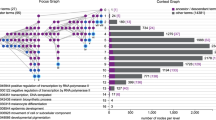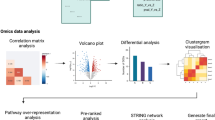Abstract
Network analysis has an increasing role in our effort to understand the complexity of biological systems. This is because of our ability to generate large data sets, where the interaction or distance between biological components can be either measured experimentally or calculated. Here we describe the use of BioLayout Express3D, an application that has been specifically designed for the integration, visualization and analysis of large network graphs derived from biological data. We describe the basic functionality of the program and its ability to display and cluster large graphs in two- and three-dimensional space, thereby rendering graphs in a highly interactive format. Although the program supports the import and display of various data formats, we provide a detailed protocol for one of its unique capabilities, the network analysis of gene expression data and a more general guide to the manipulation of graphs generated from various other data types.
This is a preview of subscription content, access via your institution
Access options
Subscribe to this journal
Receive 12 print issues and online access
$259.00 per year
only $21.58 per issue
Buy this article
- Purchase on Springer Link
- Instant access to full article PDF
Prices may be subject to local taxes which are calculated during checkout






Similar content being viewed by others
References
Reed, J.L., Famili, I., Thiele, I. & Palsson, B.O. Towards multidimensional genome annotation. Nat. Rev. Genet. 7, 130–141 (2006).
Kitano, H. Computational systems biology. Nature 420, 206–210 (2002).
Nurse, P. Systems biology: understanding cells. Nature 424, 883 (2003).
Cassman, M. Barriers to progress in systems biology. Nature 438, 1079 (2005).
Enright, A.J., Van Dongen, S. & Ouzounis, C.A. An efficient algorithm for large-scale detection of protein families. Nucleic Acids Res. 30, 1575–1584 (2002).
Enright, A.J., Kunin, V. & Ouzounis, C.A. Protein families and TRIBES in genome sequence space. Nucleic Acids Res. 31, 4632–4638 (2003).
Freeman, T.C. et al. Construction, visualisation, and clustering of transcription networks from microarray expression data. PLoS Comput. Biol. 3, 2032–2042 (2007).
Li, L., Stoeckert, C.J., Jr. & Roos, D.S. OrthoMCL: identification of ortholog groups for eukaryotic genomes. Genome Res. 13, 2178–2189 (2003).
Bader, G.D. & Enright, A.J. In Bioinformatics: A Practical Analysis of Genes and Proteins (ed. Baxevanis, A.D.) 540 (John Wiley, New York, 2005).
Pavlopoulos, G.A. et al. Arena3D: visualization of biological networks in 3D. BMC Syst. Biol. 2, 104 (2008).
Junker, B.H., Klukas, C. & Schreiber, F. VANTED: a system for advanced data analysis and visualization in the context of biological networks. BMC Bioinformatics 7, 109 (2006).
Funahashi, A., Jouraku, A., Matsuoka, Y. & Kitano, H. Integration of CellDesigner and SABIO-RK. In Silico Biol. 7, S81–S90 (2007).
Demir, E. et al. PATIKA: an integrated visual environment for collaborative construction and analysis of cellular pathways. Bioinformatics 18, 996–1003 (2002).
Cline, M.S. et al. Integration of biological networks and gene expression data using Cytoscape. Nat. Protoc. 2, 2366–2382 (2007).
Suderman, M. & Hallett, M. Tools for visually exploring biological networks. Bioinformatics 23, 2651–2659 (2007).
Pavlopoulos, G.A., Wegener, A-L. & Schneider, R. A survey of visualization tools for biological network analysis. BioData Min. 1, 12 (2008).
Franke, L. et al. Reconstruction of a functional human gene network, with an application for prioritizing positional candidate genes. Am. J. Hum. Genet. 78, 1011–1025 (2006).
Kim, S.K. et al. A gene expression map for Caenorhabditis elegans . Science 293, 2087–2092 (2001).
Lee, H.K., Hsu, A.K., Sajdak, J., Qin, J. & Pavlidis, P. Coexpression analysis of human genes across many microarray data sets. Genome Res. 14, 1085–1094 (2004).
Zhang, B. & Horvath, S. A general framework for weighted gene co-expression network analysis. Stat. Appl. Genet. Mol. Biol. 4, Article 17 (2005).
Brohee, S. & van Helden, J. Evaluation of clustering algorithms for protein–protein interaction networks. BMC Bioinformatics 7, 488 (2006).
van Dongen, S. Graph Clustering by Flow Simulation. PhD thesis, University of Utrecht (2000).
Dennis, G.S.B., Jr et al. DAVID: Database for Annotation, Visualization, and Integrated Discovery. Genome Biol. 4, P3 (2003).
Subramanian, A.T.P. et al. Gene set enrichment analysis: a knowledge-based approach for interpreting genome-wide expression profiles. Proc. Natl. Acad. Sci. USA 102, 15545–50 (2005).
Su, A.I. et al. A gene atlas of the mouse and human protein-encoding transcriptomes. Proc. Natl. Acad. Sci. USA 101, 6062–7 (2004).
Raza, S. et al. A logic-based diagram of signalling pathways central to macrophage activation. BMC Syst. Biol. 2, 36 (2008).
Fruchterman, T.M. & Rheingold, E.M. Graph drawing by force directed placement. Softw. Exp. Pract. 21, 1129–1164 (1991).
Enright, A.J. Analysis of Protein Function in Complete Genomes PhD thesis, University of Cambridge (2003).
Acknowledgements
We thank all those who have been involved with the development of BioLayout Express3D over the years including Leon Goldovsky, Markus Brosch, Ildefonso Cases and Christos Ouzounis. We also thank the BBSRC who are currently funding the development of the program (BB/F003722/1) together with the Wellcome Trust (GR077040RP) who previously provided support.
Author information
Authors and Affiliations
Contributions
T.C.F., A.T., S.v.D. and A.J.E. wrote this paper. T.C.F. and A.T. conceived and designed the individual protocols.
Corresponding author
Supplementary information
Supplementary Manual
BioLayout Express3D manual providing details of all the functions within the tool. (PDF 1503 kb)
Rights and permissions
About this article
Cite this article
Theocharidis, A., van Dongen, S., Enright, A. et al. Network visualization and analysis of gene expression data using BioLayout Express3D. Nat Protoc 4, 1535–1550 (2009). https://doi.org/10.1038/nprot.2009.177
Published:
Issue Date:
DOI: https://doi.org/10.1038/nprot.2009.177
This article is cited by
-
Genome-wide identification and integrated analysis of TCP genes controlling ginsenoside biosynthesis in Panax ginseng
BMC Plant Biology (2024)
-
Mitral valve transcriptome analysis in thirty-four age-matched Cavalier King Charles Spaniels with or without congestive heart failure caused by myxomatous mitral valve disease
Mammalian Genome (2024)
-
Genome-wide identification and systematic analysis of the HD-Zip gene family and its roles in response to pH in Panax ginseng Meyer
BMC Plant Biology (2023)
-
Temporal transcriptome profiling of floating apical out chicken enteroids suggest stability and reproducibility
Veterinary Research (2023)
-
Integrated multiomics analysis of chromosome 19 miRNA cluster in bladder cancer
Functional & Integrative Genomics (2023)
Comments
By submitting a comment you agree to abide by our Terms and Community Guidelines. If you find something abusive or that does not comply with our terms or guidelines please flag it as inappropriate.



